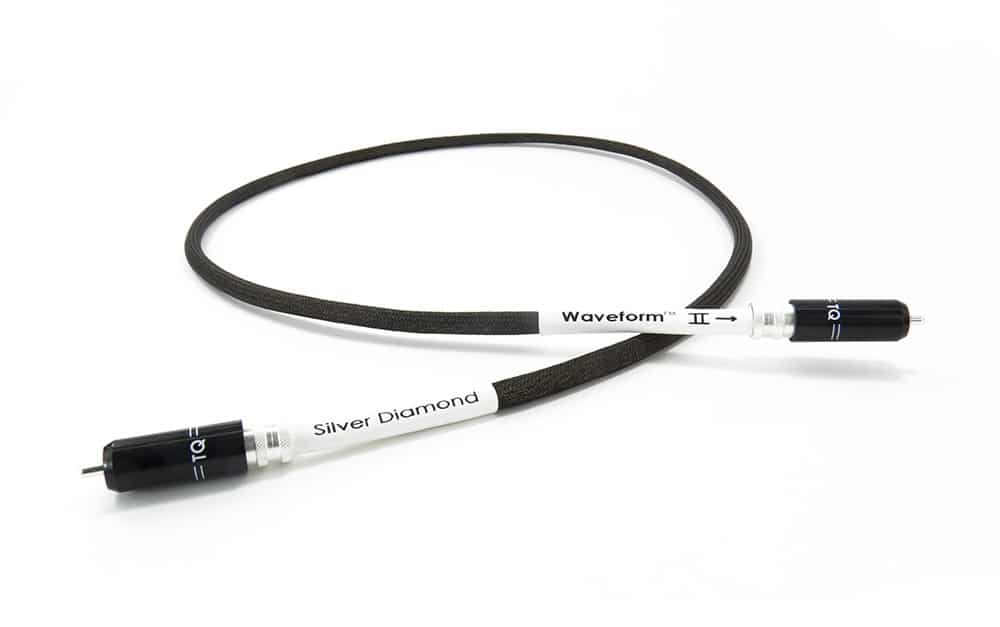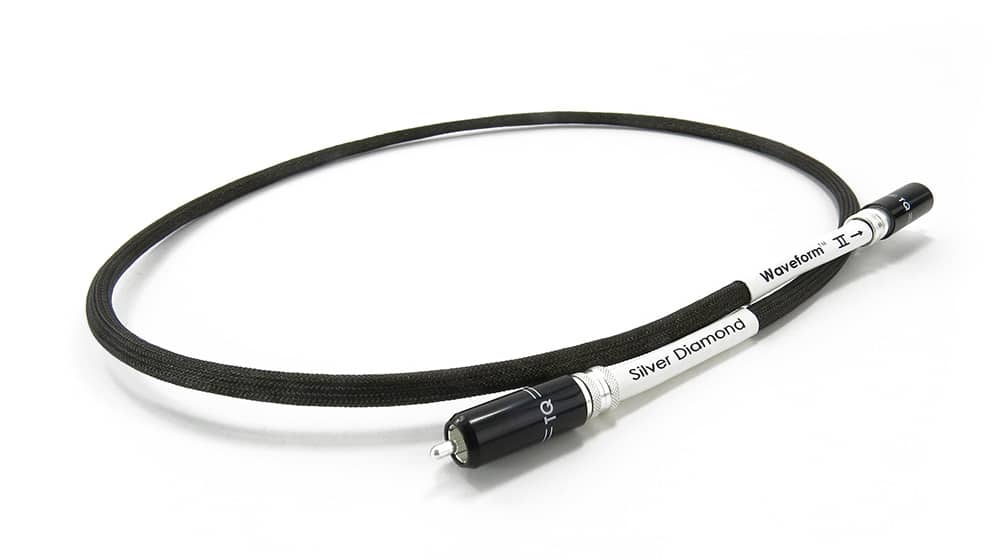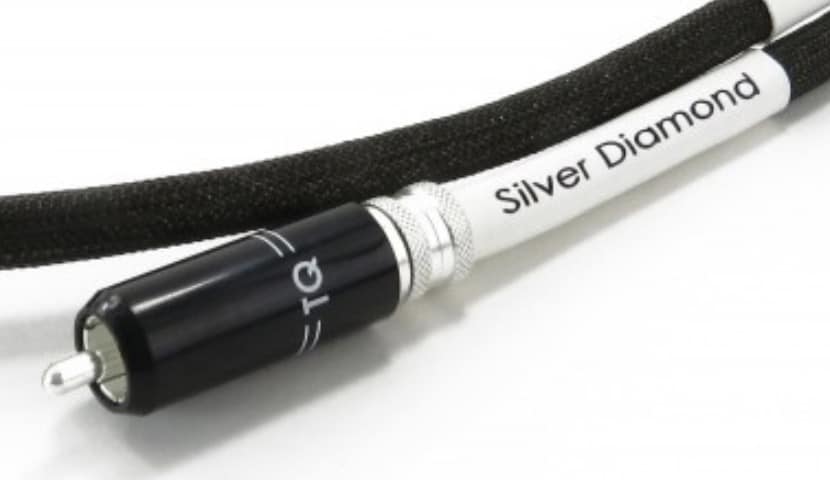The Article
Tellurium Q Silver Diamond: How Not To Be Heard
29th January 2017

Looking for the perfect RCA digital cable, Paul Rigby reviews Tellurium Q’s high-end model, the Silver Diamond
Remember the left-field comedy series, Monty Python? John Cleese? This piece of script is from a famous sketch from the TV show for you. Imagine John Cleese, with a very correct English accent, saying the next bit.
Voice Over: In this film we hope to show how not to be seen. This is Mr. E.R. Bradshaw of Napier Court, Black Lion Road London SE5. He cannot be seen. Now I am going to ask him to stand up. Mr. Bradshaw will you stand up please
(In the distance Mr Bradshaw stands up. There is a loud gunshot as Mr Bradshaw is shot in the stomach. He crumples to the ground)
Voice Over: This demonstrates the value of not being seen.
Which, as a metaphor, is exactly what hi-fi cables are all about. Although, here swop the word ‘seen’ for ‘heard’. Hi-Fi cables should not be heard. You should not add a cable to change the ‘tone’ of your hi-fi. You should never invite a friend around to your house and say, “Bob! Come ‘round to the house, you gotta hear my hi-fi cables!”
A perfect cable is totally transparent. It offers nothing. It gives you nothing. It should let all of the music through. That’s its job. The problem is, 99% of all cables get in the way. Even a little bit. So when anyone – like me – recommends a cable to you. I’m telling you that this or that cable is invisible to a greater degree.
When it comes to the role of a digital cable, though, this is one of the hardest in hi-fi because of what it does and how it does it. Normally, you have cables running from and to pre-amps and power amps to other components and speakers. We always look for top sound quality, sure, but the relationship between, say an amplifier and a pair of speakers is a relatively distant one so, if an interconnect performs less than perfectly, we can make excuses and even blame one of the other components. When you connect a transport to a DAC, though, the relationship is rather different.
Firstly, you’re connecting two related parts of essentially the same machine. At least, that’s what CD players, through history and tradition, are often seen as: formerly integrated components of the same digital genre base, separated into a rather exotic team of two: the transport and DAC.
Secondly, many users have a rough idea about what to expect in terms of sonic performance from the pairing, even before the digital cable connects the two boxes and so the digital cable itself is under a fierce spotlight.
Thirdly, probably more than any other hi-fi cable, because there might be more knowledge in terms of expected performance, that user is really looking for transparency from the cable. Any sense of tonal ‘colour’ can be a disaster.
This Silver Diamond, high-end cable from Tellurium Q has, therefore, a lot to do and performs at a high risk of failure. One wrong move, one slip up… OK, I’m over dramatising just a tad but digital cables are a breed apart.
For a digital cable of this quality and price, I felt that I had to give it a relevant platform so used it to connect my two-box, 6k Densen CD player and £11k’s worth of Vertex AQ DAC.
SOUND QUALITY
I began with jazz and the new CD from Mats Eilersten. Rubicon is a low key, meticulous and detailed piece from the ECM label.
The Silver Diamond (SD) provides unique precision in terms of how it organises the soundstage. Other cables can, on the first track Canto, have the two clarinets and sax scattered, haphazardly, over the central stereo image area whereas the SD positions each carefully to provide a more relaxed yet logical and correct posture. There is no sense of the instrumentalists slouching here – another easy problem that some cables lapse into. With the SD, the musicians are on the ball, alert and eager to please while their output is both attention grabbing and, linked inextricably, dynamic in nature.
I was also impressed with the transparency of this cable and how effectively the breathing motions of each player was conveyed. This made for a wholly more humanistic and easy-going performance, free from stress, which allowed the music to flow easily.
In specific terms, the tonal character of the treble-infused cymbals was something to behold. These big piece of metal fairly zinged along with a zippy transient speed that thrilled while the piano, an often chaotic instrument, sounded both emotional and involving. Exhibiting no smearing or blooming to harm the musicality of the piece, the piano was almost melancholy in its contribution, to the benefit of the music as a whole. Meanwhile, the bass was full and heavy with low frequency resonance, giving the bottom end a heft that supplied a strong foundation to the track as a whole.
Despite the effective performance of the SD, could you ‘get away’ with a slightly cheaper design to, as it where ‘make do’? There’s plenty of good quality cables out there that do a tremendous job. Tellurium Q itself has its own Ultra Silver cable which I have already reviewed HERE and enjoyed. Could you save yourself a few pounds (a few hundred in this case) by stepping down the range a notch? I compared the two.
I played the complex and often avant-garde guitar work of Kim Myhr on his new album, Bloom (Hubro) including electric 12-string, six-string, acoustic 12-string and electronics.
The Ultra Silver is a top notch digital cable and performed excellently but the SD is a generation ahead in terms of its capabilities, principally because of the vast amount of noise it removes from the soundstage and the clarity that it brings as a consequence.
More than that, the tonal correctness of each instrument is simply stunning. There is one sequence early on in the first track, Sort Sol, that introduces a shimmering multi-track of acoustic guitar clouds that slowly moves to the centre of the soundstage, accompanied by electronic bass effects and a deep, threatening electric bassy 12-string guitar. On the SD, this sequence transforms from the usual noisy melange into a layered, 3D soundstage effect with air and space in between each layer to give the ear a rich and transformative sonic sequence that lifts itself from merely interesting to positively thrilling.
The accuracy of each instrument is also impressive, each guitar pluck is a statement, not an insinuation while the reverb tails from each ride along the ether for a long, long time.
CONCLUSION
The Tellurium Q Silver Diamond RCA is one of the all time great digital cables that, if you can afford, you really must own. Once you’ve heard this design provide its amazing sense of realism, then any other digital connection tends to pale into insignificance. Brilliantly transparent, the Silver Diamond is likely to dominate the digital cable hill for many years to come.
TELLURIUM Q ULTRA SILVER DIAMOND RCA CABLE
Price: £1,030 for 1m
Website: www.telluriumq.com
Tel: 01458 251997
GOOD: tonality, soundstage structure, transients, emotional involvement, clarity
BAD: nothing
RATING: 9
REFERENCE SYSTEM
Densen B-475 Super Leggera CD Player
Vertex AQ Alethia DAC
Aesthetix Calypso pre-amp
Icon Audio MB845 Mk.II monoblock power amplifiers
Quad ESL-57 Speakers (with One Thing panel upgrade)
Tellurium Q Ultra Silver
Various digital cables from Black Rhodium and Audiomica







Hi Paul,
What was the cable length for this review ?
From memory – it’s now left me – I think it was 1m.